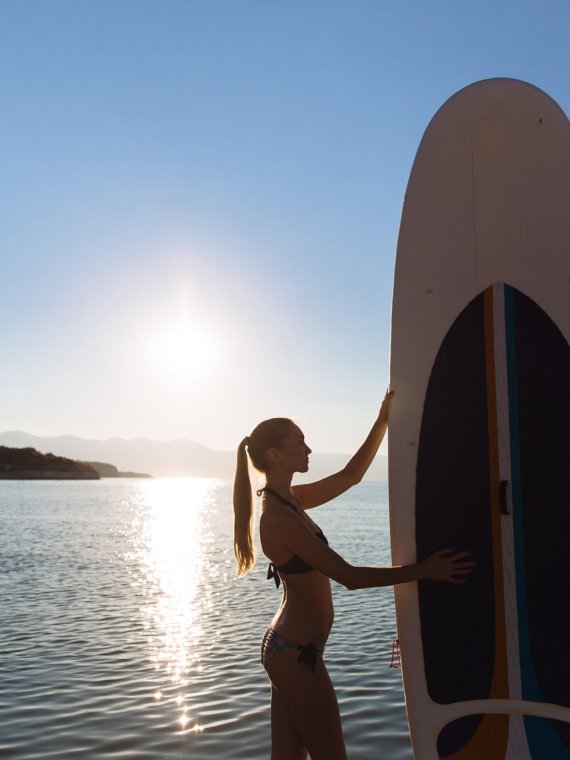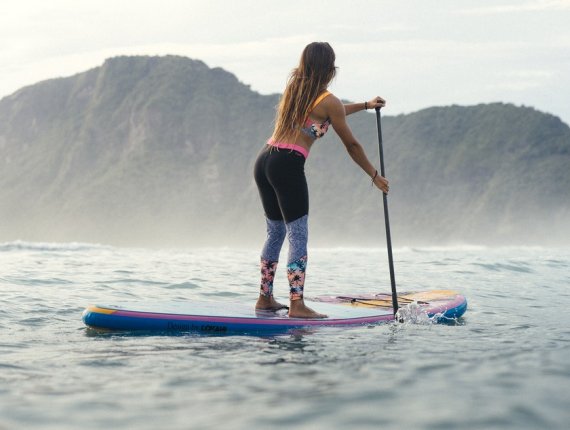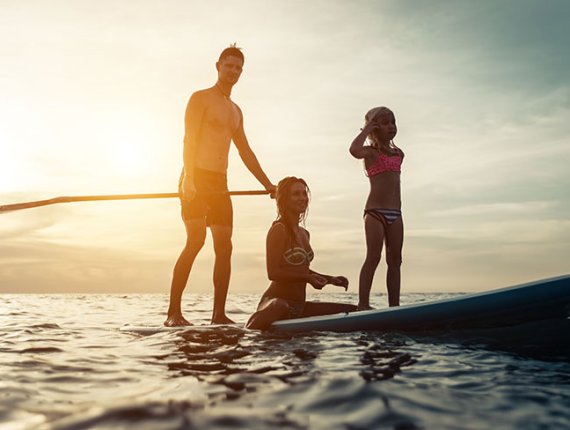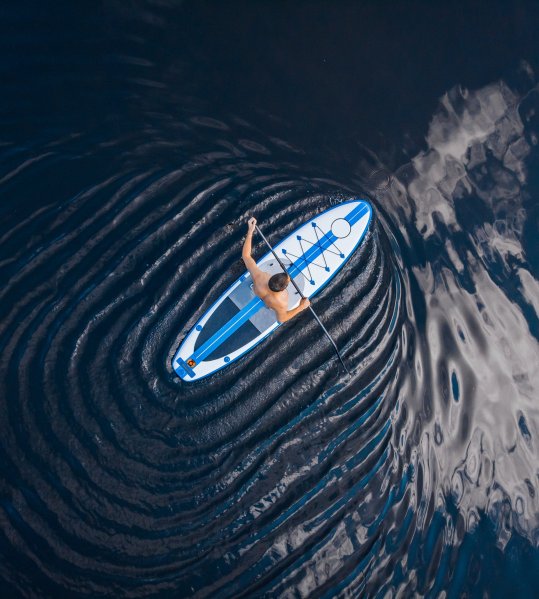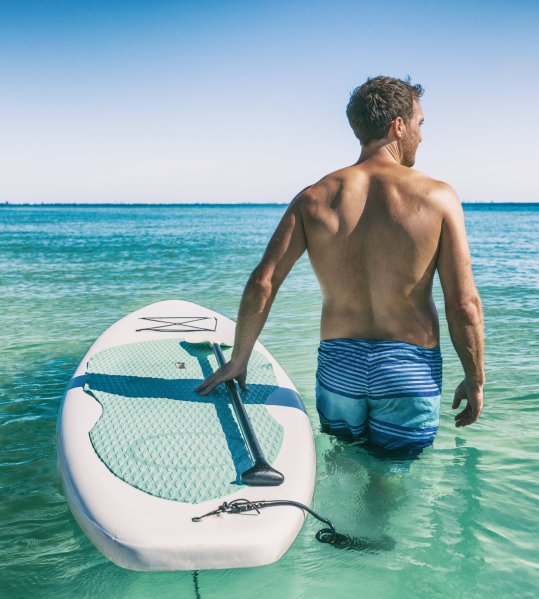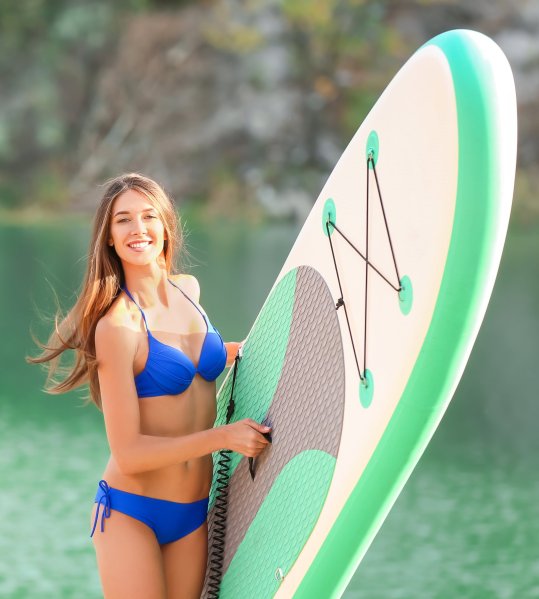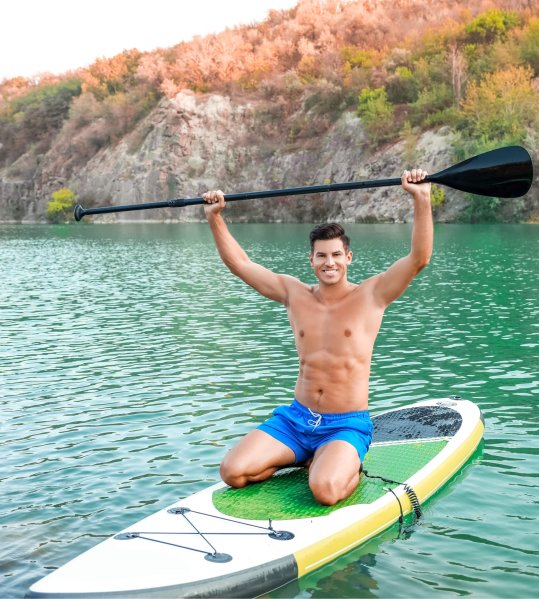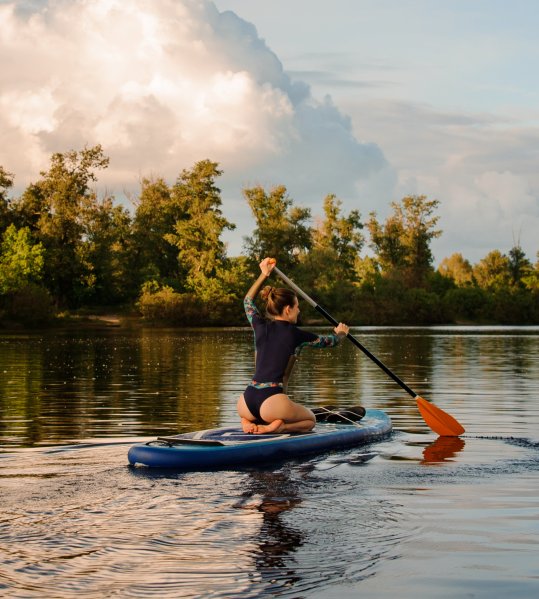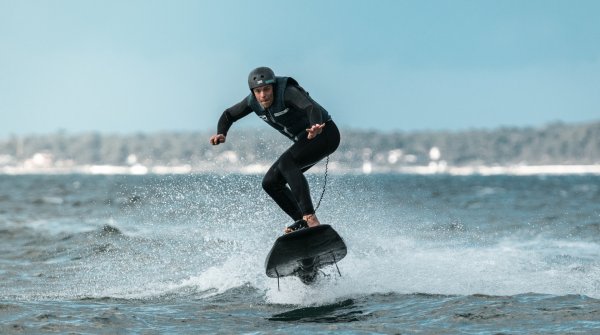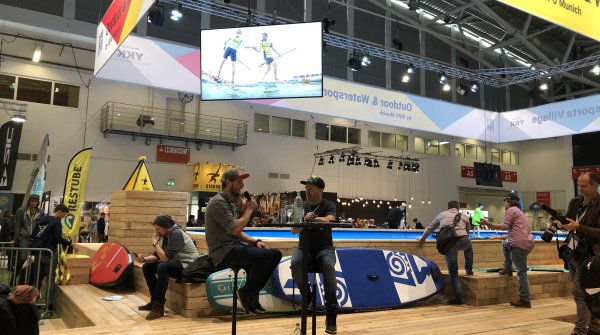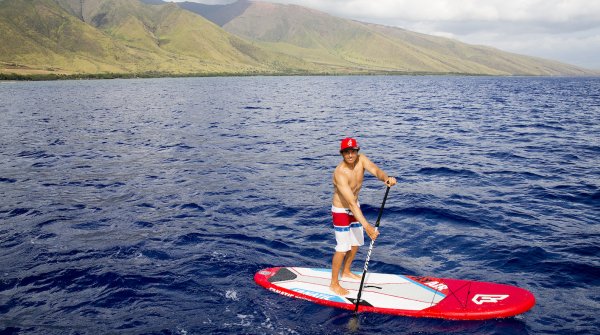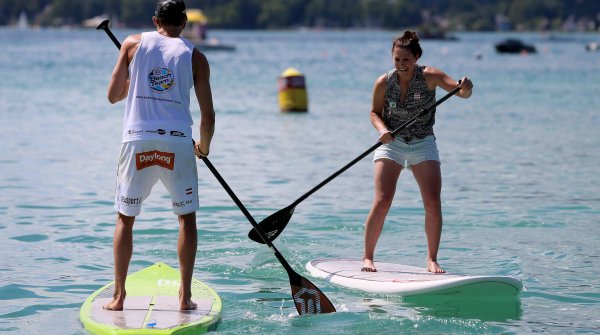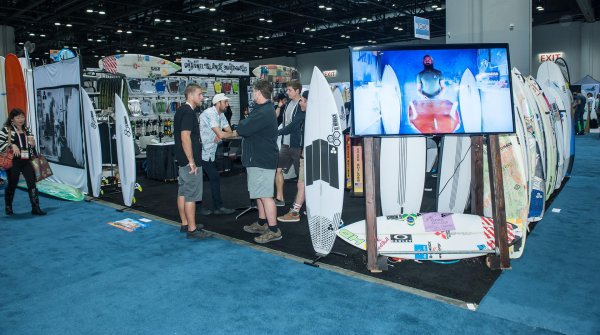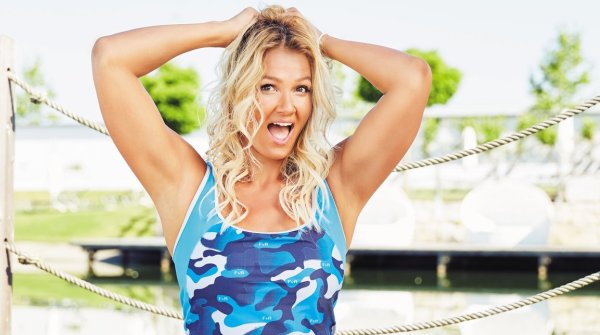SUP - Trend Sport in the Water with Fun Factor
SUP stands for stand up paddling and is considered the optimal sport in the summer on a lake, river or even in the sea. With maximum fun factor is also still the whole body trained.
What SUP actually is exactly, why you should definitely start with SUP and what types of SUP boards there are, ISPO.com has summarized here for you. In addition, we have collected tips and tricks for the next SUP excursion - whether beginner or pro.
Stand Up Paddling is a full body workout of a special kind and especially for skiers, but also snowboarders and other athletes a popular method of cross training. The summer trend offers quasi training from the neck to the little toe, because no muscle in the body remains unmoved or untrained.
SUP is suitable for athletes of any age, fitness condition, weight and size. The whole body is trained optimally and easy on the joints. With the constant balancing the deep muscles are addressed, which is very useful especially after herniated discs or other back problems.
At the same time, however, no muscle is overtrained, rather it comes to the fact that the muscles in the Back, in the trunk, the abdominal muscles and the muscles on the arms and legs balance and balance prevails.
At the same time, nature and the water around the athlete have an enormously calming and balancing effect, which makes SUP provides relaxation for mind and soul.
The answer to this question is simple, because SUP is good for fitness and health and it makes even more fun. In the beginning, you can also simply borrow the equipment, which keeps the financial outlay even lower than the purchase for the time being. With a little practice, SUP is a small adventure in itself, which fits perfectly to a summer day outdoors and also trains the shoulder, back and torso muscles.
SUP is also so trendy because it is a sport for the whole family. Especially for children, this sport is interesting and easy to manage. Parents should note that when SUP excursion together, the slowest in the family sets the pace and the first tour with the kids on the board should not be more than 10 kilometers long.
To make the trend sport SUP really fun, it is for beginners to consider some points and especially to put on the right board. To this end, SUP coach Raphale Kuner, who is a training instructor of the American Canoe Association, gives a few tips. He advises beginners to a slightly wider and longer board, but especially one that fits the body weight of the paddler. Also crucial is where you want to be with his SUP on the road and what the goal is - distance, speed or prefer surfing on the wave.
In addition to the board, it needs the right paddle. Before it goes, still quickly put on the life jacket and pack the life buoy.
The technique in stand up paddling is simple, because you stand with your feet hip-width apart and exactly parallel to the grip on the board. The knees are slightly bent to compensate for smaller waves. The upper arm on the handle of the paddle, also called the pressure arm, is vertically above the paddle blade and performs all paddling movements. The so-called pull arm grips the spar about shoulder width below the handle and is the pivot point for the paddle movements. It should almost always remain stretched.
As for the technique in paddling, there are three phases here, namely the piercing phase, the pulling phase and finally the retrieval phase. In the first stage, the paddle should be dipped into the water as far forward as possible, and once the paddle is completely submerged, the pull phase begins. It is helpful to think of pulling the SUP board towards the paddle and not the other way around. The last phase, the retrieval phase, performs the pressure arm in the form of a lateral movement, which moves the paddle out of the water and after a 90-degree rotation of the paddle blade is returned flat over the surface of the water.
Who is already addicted to the new summer trend sport, which is of course considering to buy its own SUP board. Many questions arise, such as whether to buy an inflatable or rather a hardboard. The former is the clear best seller and scores with numerous advantages - but especially with the fact that despite a more compact size, the technology is almost equivalent compared to the hardboard.
As for the length, width and thickness of the SUP board, there is a simple principle to keep in mind - the longer, wider and thicker the board, the easier it is to paddle with it, especially for beginners.
SUP or Stand Up Paddling offers something for everyone: Whether at the sea, on the river or at the lake, whether endurance training, relaxation or action, the possibilities are many. However, anyone who wants to buy a SUP is first faced with the question: Inflatable or hardboard? And should it be a touring or an all-round board?
Before deciding on your personal favorite board, you should be sure whether you prefer an inflatable or a hardboard. Recreational paddlers mainly choose inflatable boards, as they are easier to transport and are more stable in the water compared to hardboards. Thus, especially for inexperienced paddlers, success can be achieved more quickly. Inflatable boards are the epitome of easy paddling. They convince by their light weight and their robustness against stone and rock.
Summer, sun, vacation and water sports belong together for many. And Stand Up Paddling comes just right, because hardly any other sport in the cool water is so easy to learn and so much fun. Since you can be both relaxed with it on the lake or river, but also an effective workout perform or even race, the target audience for this water fun is very broad.
Independently of whether you simply want to paddle in front of you or also undertake trips in faster flowing waters or even in white water, one thing is clear: With SUP, pure nature and optimal training effects come together. Except for the board, the equipment is minimal and not very cost-intensive, you can learn the summer trend both self-taught and in courses. Especially the latter is recommended, since you immediately get taught the proper handling of the paddle, but also the turning technique.
Overall, the very low barriers to entry, but also the versatility of SUP and the fun in the fresh air and water are reasons why SUP is so widespread. A major advantage is also that here pure physical strength is sufficient and you do not have to resort to engine power or anything else that has a negative effect on the environment.
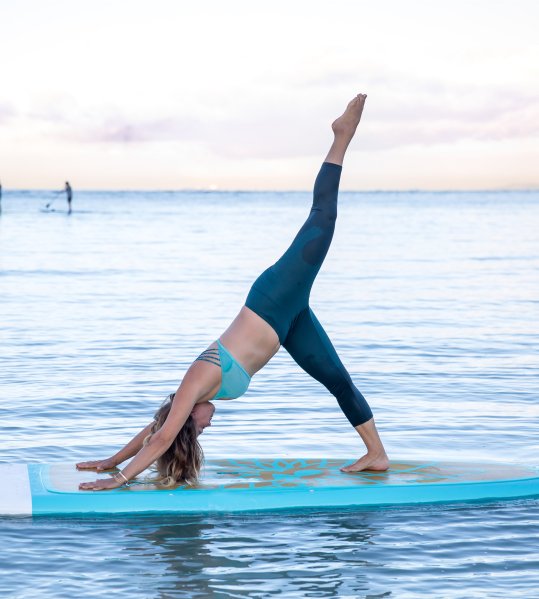
Into the water, up on the board, the paddle in hand and the view into the distance. More and more people are discovering stand up paddling - a sport that is booming like crazy.
The technique is not complicated, the sport is calm (if the swell plays along). In addition, the width of the SUP board gives enough stability to be able to paddle relaxed on it.
Compared to surfing or kayaking, this is a water sport that is calming yet lots of fun while exercising the whole body.
What does the perfect SUP workout actually look like?
Sonni Hönscheid, three-time world champion in ocean crossing around Hawaii, gives tips for SUP-Profis und Einsteiger. She goes into detail about optimal nutrition and explains what you should definitely look for when buying a SUP board. In addition, the SUP world champion gives private insights and talks about her preparation for important races.
Finally, she reveals useful tips against falling into the water and explains why sharks in the sea are such a great danger for SUP athletes.
In principle, SUP is possible everywhere where the water depth under the keel is at least 30 centimeters. Thus SUP is possible on smaller streams as well as on rivers, lakes and in seas. Who lives in the big city - such as Potsdam, Berlin and the Brandenburg hinterland - which finds ideal opportunities and numerous waters that invite to SUP.
.
Even though stand up paddling is a trend on its own, there are further developments that make the sport even more attractive for some target groups. Particularly noteworthy, for example, is sit-on-top paddling, in which a removable kayak seat is mounted on the board. Because who suffers from back injuries or has back problems, is often overwhelmed with the simple SUP or simply can not perform it.
With the kayak seat, which can be mounted in a few simple steps, and with double paddles, the board can be used like a kayak. But not only athletes with restrictions love this form of SUP, but also families or dog owners like to fall back on this variant.
Wingsurfing or. Wingfoiling is still very young as a sport, but is becoming increasingly popular. The Wing is a small inflatable dragon that has similarities to a kite in its manufacture. In combination with the Wingfoil board or a snowboard or even a SUP board, it can be used on land as well as in the water.
As already mentioned, many sports enthusiasts like to take their four-legged friends, especially since many dogs love water. However, it should be noted that you should take your four-legged friend on the SUP board only when you yourself are safe paddling. Because the dog on the bow can quickly upset the balance and thus bring the board to capsize.
Invented SUP probably the Polynesians, although the real popularity goes back to Hawaii and its neighboring islands. In the 1960s, the Beach Boys there on their long boards and with canoe paddles made sure that tourists could experience their first waves. This also gave rise to the term Beach Boy Surfing.
Just after the turn of the millennium, the Hawaiian surfers around Dave Kalama and Archie Kalepa, Rick Thomas and Laird Hamilton revived the SUP and conceived the trend sport as an alternative training method in the sea when there were just no waves.
